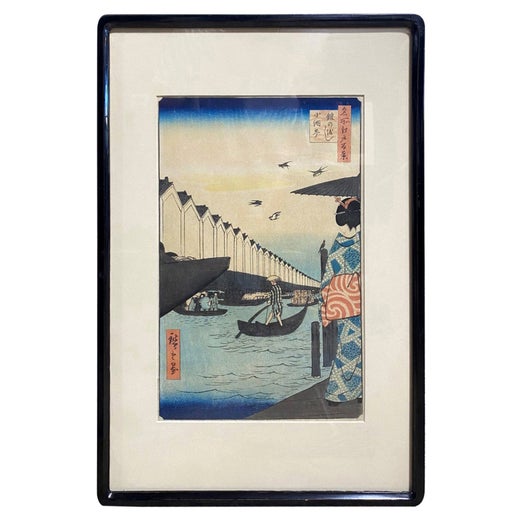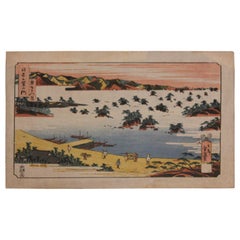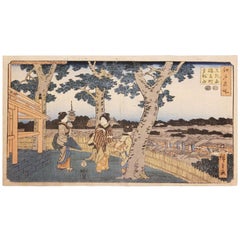Utagawa Hiroshige (Ando Hiroshige)Nihon Embankment in Yoshiwara Japanese Woodblock Print1857
1857
About the Item
- Creator:Utagawa Hiroshige (Ando Hiroshige) (1797-1858, Japanese)
- Creation Year:1857
- Dimensions:Height: 13.75 in (34.93 cm)Width: 9.5 in (24.13 cm)Depth: 0.004 in (0.11 mm)
- Medium:
- Movement & Style:
- Period:
- Condition:Wear is consistent with age.
- Gallery Location:Houston, TX
- Reference Number:Seller: CA35.2019.0627.11501stDibs: LU55134730021
Utagawa Hiroshige (Ando Hiroshige)
Born in Edo as Tokutaro Ando, Utagawa Hiroshige (also known as Andō Hiroshige) grew up in a minor samurai family. His father belonged to the firefighting force assigned to Edo Castle. It is here that Hiroshige was given his first exposure to art: legend has it that a fellow fireman tutored him in the Kano school of painting, though Hiroshige’s first official teacher was Rinsai.
Though Hiroshige tried to join Utagawa Toyokuni's studio, he was turned away. In 1811, young Hiroshige entered an apprenticeship with the celebrated Utagawa Toyohiro. After only a year, he was bestowed with the artist name Hiroshige. He soon gave up his role in the fire department to focus entirely on painting and print design. During this time he studied painting, intrigued by the Shijo school. Hiroshige’s artistic genius went largely unnoticed until 1832.
In Hiroshige's groundbreaking series of Japanese woodblock prints, The “53 Stations of the Tokaido” (1832–33), he captured the journey along the Tokaido road, the highway connecting Edo to Kyoto, the imperial capital. With the Tokugawa Shogunate relaxing centuries of age-old restrictions on travel, urban populations embraced travel art and Hiroshige became one of the most prominent and successful ukiyo-e artists. He also produced kacho-e (bird-and-flower pictures) to enormous success. In 1858, at the age of 61, he passed away as a result of the Edo cholera epidemic.
Original Hiroshige woodblock prints continue to convey the beauty of Japan and provide insight into the everyday life of its citizens during the Edo period. The appeal of his tender, lyrical landscapes was not restricted to the Japanese audience. Hiroshige’s work had a profound influence on the Impressionists and Post-Impressionists of Europe: Toulouse-Lautrec was fascinated with Hiroshige’s daring diagonal compositions and inventive use of perspective, while Van Gogh literally copied two of Hiroshige's prints from the famous series, “100 Famous Views of Edo” in oil paint.
Find original Utagawa Hiroshige prints and other art for sale on 1stDibs.
(Biography provided by Robert Azensky Fine Art)

You May Also Like
Early 19th Century Edo Figurative Prints
Watercolor, Handmade Paper, Woodcut
Late 19th Century Edo Figurative Prints
Watercolor, Handmade Paper, Woodcut
1820s Edo Figurative Prints
Ink, Rice Paper, Woodcut
Early 19th Century Edo Figurative Prints
Paper, Ink, Woodcut
Mid-19th Century Edo Figurative Prints
Paper, Ink, Woodcut
1880s Edo Figurative Prints
Paper, Ink, Woodcut
Late 18th Century Edo Figurative Prints
Woodcut, Rice Paper
Late 18th Century Edo Landscape Prints
Paper, Ink, Woodcut
1920s Edo Landscape Prints
Paper, Ink, Woodcut
1880s Edo Figurative Prints
Ink, Rice Paper, Woodcut
More From This Seller
View All1850s Edo Landscape Prints
Woodcut
1850s Edo Figurative Prints
Woodcut
20th Century Modern Landscape Prints
Woodcut
Mid-20th Century Expressionist Landscape Prints
Woodcut
20th Century Abstract Landscape Prints
Woodcut
1930s Realist Landscape Prints
Etching


